An Expert System Design to Categorize Student Intelligence: MITS5509
VerifiedAdded on 2022/10/19
|9
|2063
|438
Report
AI Summary
This report analyzes a research paper focused on designing an expert system to categorize students based on their multiple intelligences. The paper, titled "An Expert System Design to Categorize Multiple Intelligence of Students," explores the application of artificial intelligence (AI) in education. The report provides an overview of the expert system's architecture, its advantages, and the significance of the theory of multiple intelligences. The methodology involves a descriptive qualitative design, employing an inductive approach and secondary data sources like journal papers and online resources. The findings highlight the expert system's capability to solve complex problems by utilizing inference and knowledge, emphasizing its potential to classify students' abilities for different fields. The report also discusses the issues highlighted by the authors, such as the limited availability of experts and the challenges of managing multiple tasks. The conclusion emphasizes the expert system's role in providing effective training, planning resources, and aiding in decision-making across various domains. This analysis serves to understand the contribution of expert systems in problem-solving within the context of intelligent systems and AI.

An Expert System Design to Categorize
Multiple Intelligence of Students
Multiple Intelligence of Students
Paraphrase This Document
Need a fresh take? Get an instant paraphrase of this document with our AI Paraphraser
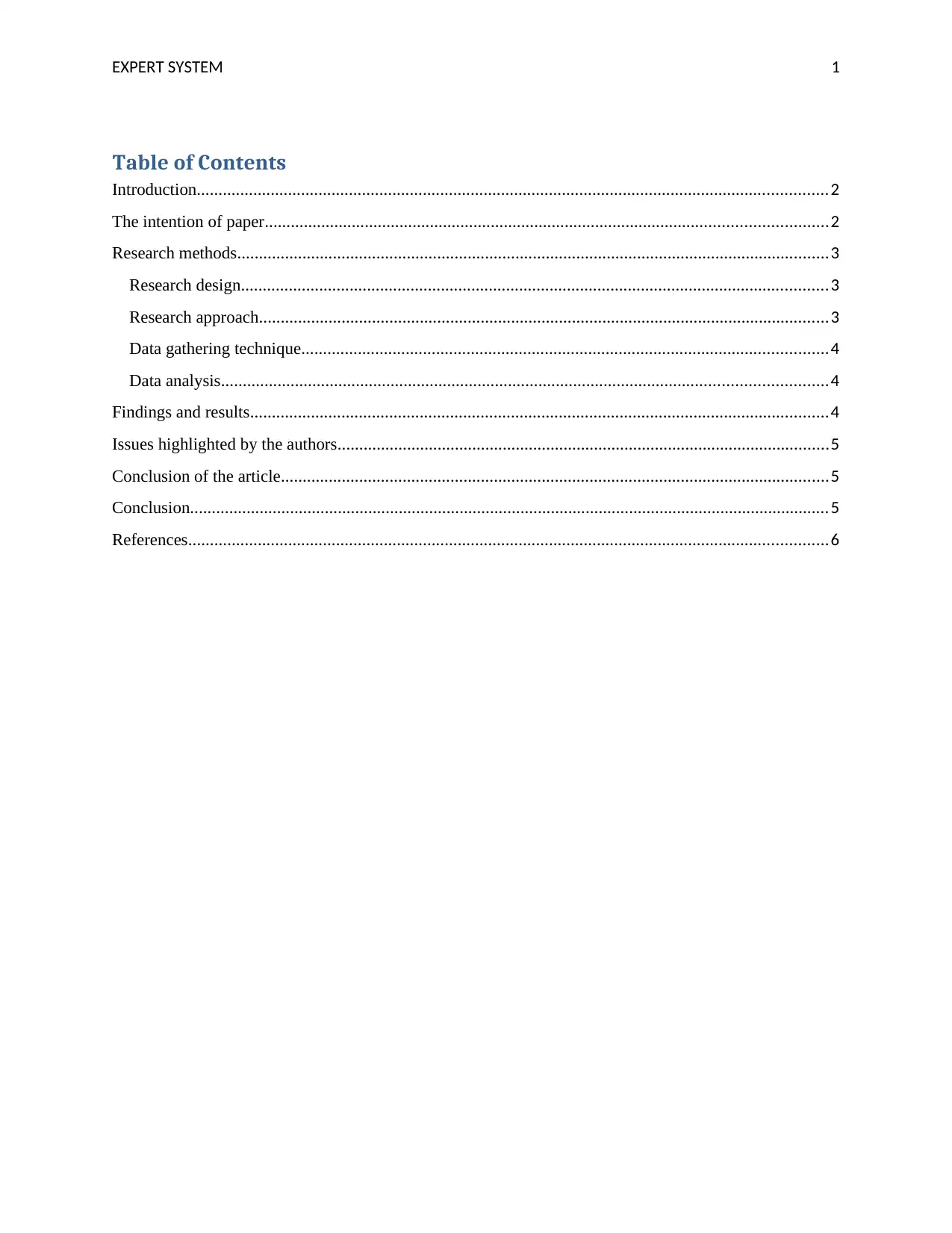
EXPERT SYSTEM 1
Table of Contents
Introduction.................................................................................................................................................2
The intention of paper.................................................................................................................................2
Research methods........................................................................................................................................3
Research design.......................................................................................................................................3
Research approach...................................................................................................................................3
Data gathering technique.........................................................................................................................4
Data analysis...........................................................................................................................................4
Findings and results.....................................................................................................................................4
Issues highlighted by the authors.................................................................................................................5
Conclusion of the article..............................................................................................................................5
Conclusion...................................................................................................................................................5
References...................................................................................................................................................6
Table of Contents
Introduction.................................................................................................................................................2
The intention of paper.................................................................................................................................2
Research methods........................................................................................................................................3
Research design.......................................................................................................................................3
Research approach...................................................................................................................................3
Data gathering technique.........................................................................................................................4
Data analysis...........................................................................................................................................4
Findings and results.....................................................................................................................................4
Issues highlighted by the authors.................................................................................................................5
Conclusion of the article..............................................................................................................................5
Conclusion...................................................................................................................................................5
References...................................................................................................................................................6
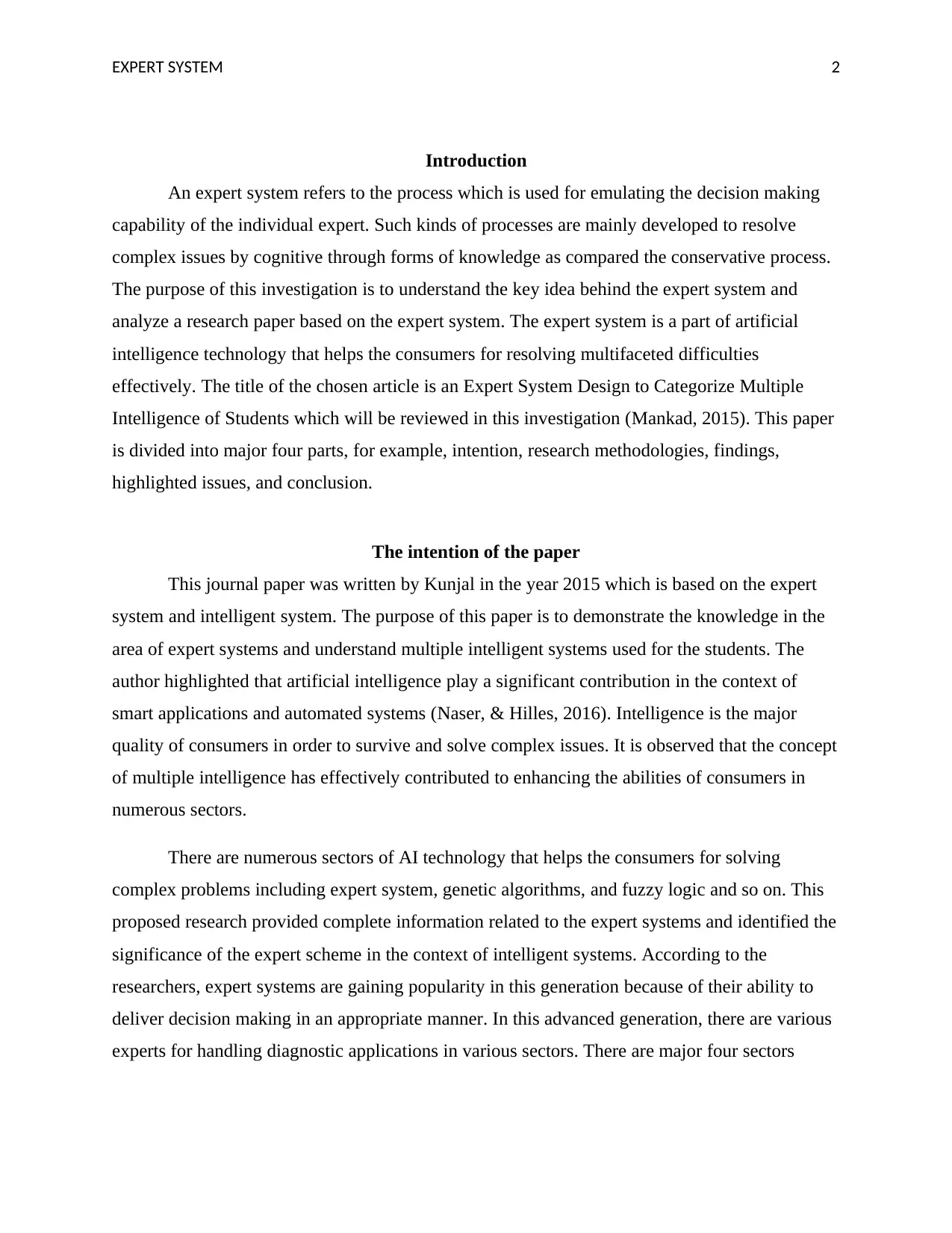
EXPERT SYSTEM 2
Introduction
An expert system refers to the process which is used for emulating the decision making
capability of the individual expert. Such kinds of processes are mainly developed to resolve
complex issues by cognitive through forms of knowledge as compared the conservative process.
The purpose of this investigation is to understand the key idea behind the expert system and
analyze a research paper based on the expert system. The expert system is a part of artificial
intelligence technology that helps the consumers for resolving multifaceted difficulties
effectively. The title of the chosen article is an Expert System Design to Categorize Multiple
Intelligence of Students which will be reviewed in this investigation (Mankad, 2015). This paper
is divided into major four parts, for example, intention, research methodologies, findings,
highlighted issues, and conclusion.
The intention of the paper
This journal paper was written by Kunjal in the year 2015 which is based on the expert
system and intelligent system. The purpose of this paper is to demonstrate the knowledge in the
area of expert systems and understand multiple intelligent systems used for the students. The
author highlighted that artificial intelligence play a significant contribution in the context of
smart applications and automated systems (Naser, & Hilles, 2016). Intelligence is the major
quality of consumers in order to survive and solve complex issues. It is observed that the concept
of multiple intelligence has effectively contributed to enhancing the abilities of consumers in
numerous sectors.
There are numerous sectors of AI technology that helps the consumers for solving
complex problems including expert system, genetic algorithms, and fuzzy logic and so on. This
proposed research provided complete information related to the expert systems and identified the
significance of the expert scheme in the context of intelligent systems. According to the
researchers, expert systems are gaining popularity in this generation because of their ability to
deliver decision making in an appropriate manner. In this advanced generation, there are various
experts for handling diagnostic applications in various sectors. There are major four sectors
Introduction
An expert system refers to the process which is used for emulating the decision making
capability of the individual expert. Such kinds of processes are mainly developed to resolve
complex issues by cognitive through forms of knowledge as compared the conservative process.
The purpose of this investigation is to understand the key idea behind the expert system and
analyze a research paper based on the expert system. The expert system is a part of artificial
intelligence technology that helps the consumers for resolving multifaceted difficulties
effectively. The title of the chosen article is an Expert System Design to Categorize Multiple
Intelligence of Students which will be reviewed in this investigation (Mankad, 2015). This paper
is divided into major four parts, for example, intention, research methodologies, findings,
highlighted issues, and conclusion.
The intention of the paper
This journal paper was written by Kunjal in the year 2015 which is based on the expert
system and intelligent system. The purpose of this paper is to demonstrate the knowledge in the
area of expert systems and understand multiple intelligent systems used for the students. The
author highlighted that artificial intelligence play a significant contribution in the context of
smart applications and automated systems (Naser, & Hilles, 2016). Intelligence is the major
quality of consumers in order to survive and solve complex issues. It is observed that the concept
of multiple intelligence has effectively contributed to enhancing the abilities of consumers in
numerous sectors.
There are numerous sectors of AI technology that helps the consumers for solving
complex problems including expert system, genetic algorithms, and fuzzy logic and so on. This
proposed research provided complete information related to the expert systems and identified the
significance of the expert scheme in the context of intelligent systems. According to the
researchers, expert systems are gaining popularity in this generation because of their ability to
deliver decision making in an appropriate manner. In this advanced generation, there are various
experts for handling diagnostic applications in various sectors. There are major four sectors
⊘ This is a preview!⊘
Do you want full access?
Subscribe today to unlock all pages.

Trusted by 1+ million students worldwide
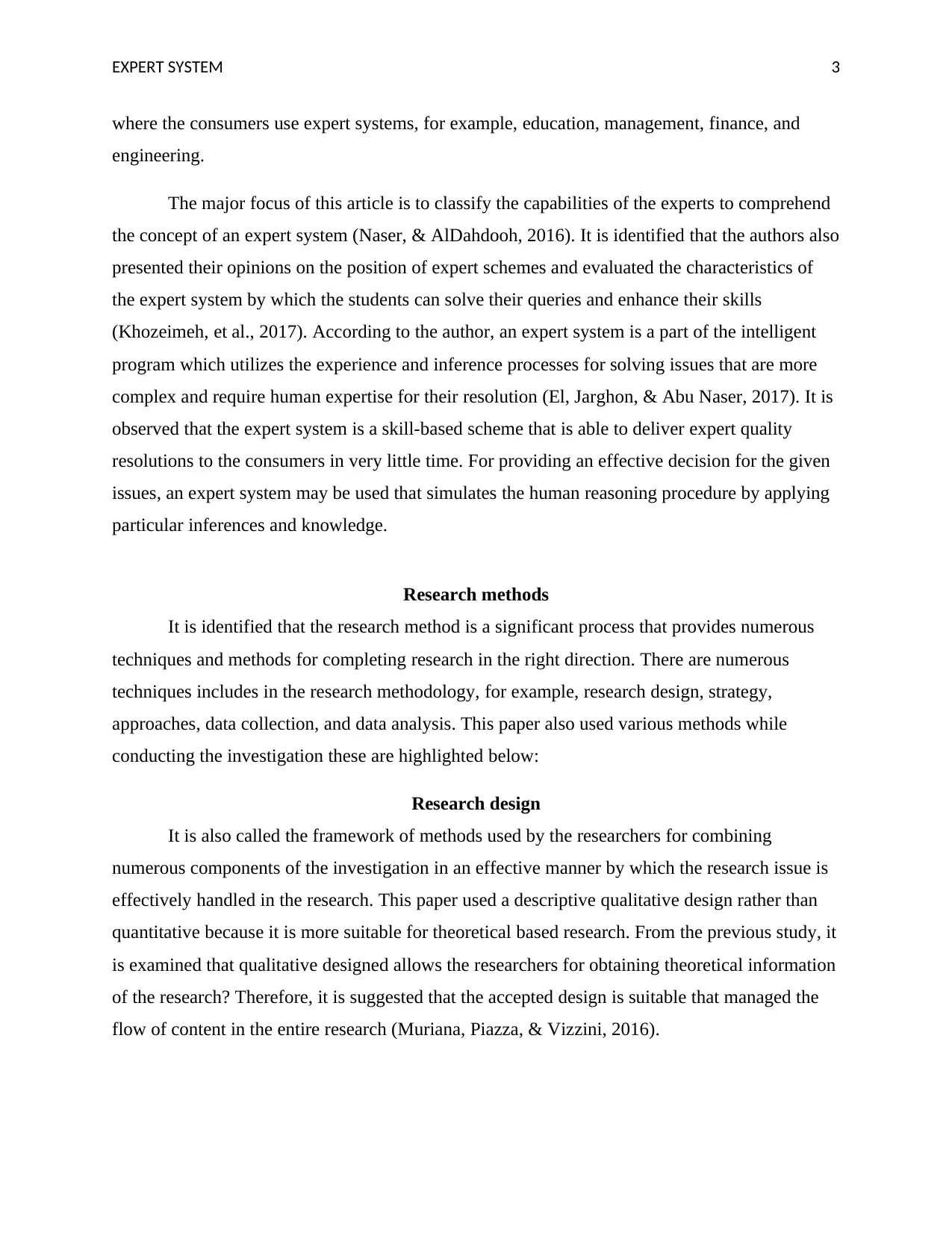
EXPERT SYSTEM 3
where the consumers use expert systems, for example, education, management, finance, and
engineering.
The major focus of this article is to classify the capabilities of the experts to comprehend
the concept of an expert system (Naser, & AlDahdooh, 2016). It is identified that the authors also
presented their opinions on the position of expert schemes and evaluated the characteristics of
the expert system by which the students can solve their queries and enhance their skills
(Khozeimeh, et al., 2017). According to the author, an expert system is a part of the intelligent
program which utilizes the experience and inference processes for solving issues that are more
complex and require human expertise for their resolution (El, Jarghon, & Abu Naser, 2017). It is
observed that the expert system is a skill-based scheme that is able to deliver expert quality
resolutions to the consumers in very little time. For providing an effective decision for the given
issues, an expert system may be used that simulates the human reasoning procedure by applying
particular inferences and knowledge.
Research methods
It is identified that the research method is a significant process that provides numerous
techniques and methods for completing research in the right direction. There are numerous
techniques includes in the research methodology, for example, research design, strategy,
approaches, data collection, and data analysis. This paper also used various methods while
conducting the investigation these are highlighted below:
Research design
It is also called the framework of methods used by the researchers for combining
numerous components of the investigation in an effective manner by which the research issue is
effectively handled in the research. This paper used a descriptive qualitative design rather than
quantitative because it is more suitable for theoretical based research. From the previous study, it
is examined that qualitative designed allows the researchers for obtaining theoretical information
of the research? Therefore, it is suggested that the accepted design is suitable that managed the
flow of content in the entire research (Muriana, Piazza, & Vizzini, 2016).
where the consumers use expert systems, for example, education, management, finance, and
engineering.
The major focus of this article is to classify the capabilities of the experts to comprehend
the concept of an expert system (Naser, & AlDahdooh, 2016). It is identified that the authors also
presented their opinions on the position of expert schemes and evaluated the characteristics of
the expert system by which the students can solve their queries and enhance their skills
(Khozeimeh, et al., 2017). According to the author, an expert system is a part of the intelligent
program which utilizes the experience and inference processes for solving issues that are more
complex and require human expertise for their resolution (El, Jarghon, & Abu Naser, 2017). It is
observed that the expert system is a skill-based scheme that is able to deliver expert quality
resolutions to the consumers in very little time. For providing an effective decision for the given
issues, an expert system may be used that simulates the human reasoning procedure by applying
particular inferences and knowledge.
Research methods
It is identified that the research method is a significant process that provides numerous
techniques and methods for completing research in the right direction. There are numerous
techniques includes in the research methodology, for example, research design, strategy,
approaches, data collection, and data analysis. This paper also used various methods while
conducting the investigation these are highlighted below:
Research design
It is also called the framework of methods used by the researchers for combining
numerous components of the investigation in an effective manner by which the research issue is
effectively handled in the research. This paper used a descriptive qualitative design rather than
quantitative because it is more suitable for theoretical based research. From the previous study, it
is examined that qualitative designed allows the researchers for obtaining theoretical information
of the research? Therefore, it is suggested that the accepted design is suitable that managed the
flow of content in the entire research (Muriana, Piazza, & Vizzini, 2016).
Paraphrase This Document
Need a fresh take? Get an instant paraphrase of this document with our AI Paraphraser
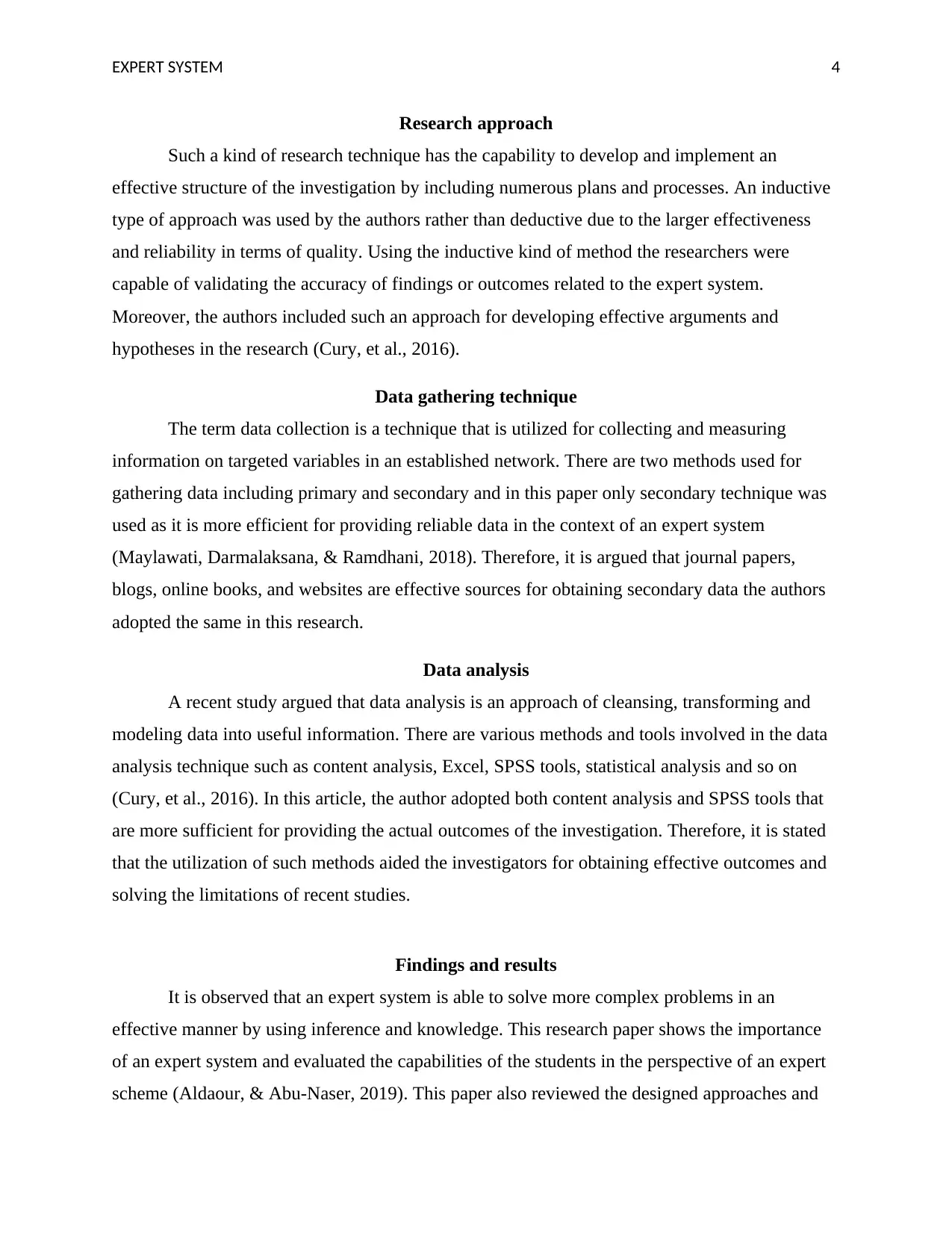
EXPERT SYSTEM 4
Research approach
Such a kind of research technique has the capability to develop and implement an
effective structure of the investigation by including numerous plans and processes. An inductive
type of approach was used by the authors rather than deductive due to the larger effectiveness
and reliability in terms of quality. Using the inductive kind of method the researchers were
capable of validating the accuracy of findings or outcomes related to the expert system.
Moreover, the authors included such an approach for developing effective arguments and
hypotheses in the research (Cury, et al., 2016).
Data gathering technique
The term data collection is a technique that is utilized for collecting and measuring
information on targeted variables in an established network. There are two methods used for
gathering data including primary and secondary and in this paper only secondary technique was
used as it is more efficient for providing reliable data in the context of an expert system
(Maylawati, Darmalaksana, & Ramdhani, 2018). Therefore, it is argued that journal papers,
blogs, online books, and websites are effective sources for obtaining secondary data the authors
adopted the same in this research.
Data analysis
A recent study argued that data analysis is an approach of cleansing, transforming and
modeling data into useful information. There are various methods and tools involved in the data
analysis technique such as content analysis, Excel, SPSS tools, statistical analysis and so on
(Cury, et al., 2016). In this article, the author adopted both content analysis and SPSS tools that
are more sufficient for providing the actual outcomes of the investigation. Therefore, it is stated
that the utilization of such methods aided the investigators for obtaining effective outcomes and
solving the limitations of recent studies.
Findings and results
It is observed that an expert system is able to solve more complex problems in an
effective manner by using inference and knowledge. This research paper shows the importance
of an expert system and evaluated the capabilities of the students in the perspective of an expert
scheme (Aldaour, & Abu-Naser, 2019). This paper also reviewed the designed approaches and
Research approach
Such a kind of research technique has the capability to develop and implement an
effective structure of the investigation by including numerous plans and processes. An inductive
type of approach was used by the authors rather than deductive due to the larger effectiveness
and reliability in terms of quality. Using the inductive kind of method the researchers were
capable of validating the accuracy of findings or outcomes related to the expert system.
Moreover, the authors included such an approach for developing effective arguments and
hypotheses in the research (Cury, et al., 2016).
Data gathering technique
The term data collection is a technique that is utilized for collecting and measuring
information on targeted variables in an established network. There are two methods used for
gathering data including primary and secondary and in this paper only secondary technique was
used as it is more efficient for providing reliable data in the context of an expert system
(Maylawati, Darmalaksana, & Ramdhani, 2018). Therefore, it is argued that journal papers,
blogs, online books, and websites are effective sources for obtaining secondary data the authors
adopted the same in this research.
Data analysis
A recent study argued that data analysis is an approach of cleansing, transforming and
modeling data into useful information. There are various methods and tools involved in the data
analysis technique such as content analysis, Excel, SPSS tools, statistical analysis and so on
(Cury, et al., 2016). In this article, the author adopted both content analysis and SPSS tools that
are more sufficient for providing the actual outcomes of the investigation. Therefore, it is stated
that the utilization of such methods aided the investigators for obtaining effective outcomes and
solving the limitations of recent studies.
Findings and results
It is observed that an expert system is able to solve more complex problems in an
effective manner by using inference and knowledge. This research paper shows the importance
of an expert system and evaluated the capabilities of the students in the perspective of an expert
scheme (Aldaour, & Abu-Naser, 2019). This paper also reviewed the designed approaches and
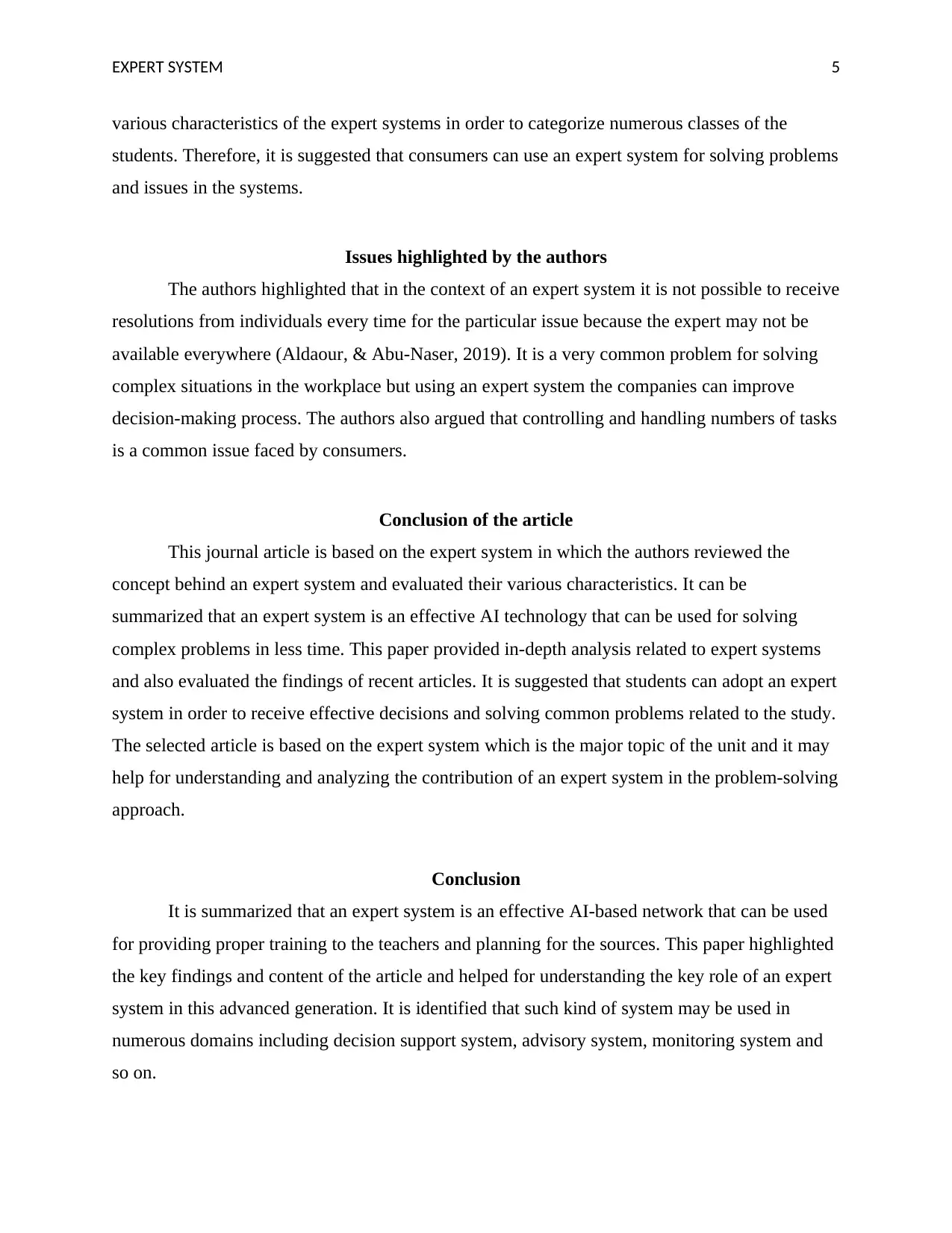
EXPERT SYSTEM 5
various characteristics of the expert systems in order to categorize numerous classes of the
students. Therefore, it is suggested that consumers can use an expert system for solving problems
and issues in the systems.
Issues highlighted by the authors
The authors highlighted that in the context of an expert system it is not possible to receive
resolutions from individuals every time for the particular issue because the expert may not be
available everywhere (Aldaour, & Abu-Naser, 2019). It is a very common problem for solving
complex situations in the workplace but using an expert system the companies can improve
decision-making process. The authors also argued that controlling and handling numbers of tasks
is a common issue faced by consumers.
Conclusion of the article
This journal article is based on the expert system in which the authors reviewed the
concept behind an expert system and evaluated their various characteristics. It can be
summarized that an expert system is an effective AI technology that can be used for solving
complex problems in less time. This paper provided in-depth analysis related to expert systems
and also evaluated the findings of recent articles. It is suggested that students can adopt an expert
system in order to receive effective decisions and solving common problems related to the study.
The selected article is based on the expert system which is the major topic of the unit and it may
help for understanding and analyzing the contribution of an expert system in the problem-solving
approach.
Conclusion
It is summarized that an expert system is an effective AI-based network that can be used
for providing proper training to the teachers and planning for the sources. This paper highlighted
the key findings and content of the article and helped for understanding the key role of an expert
system in this advanced generation. It is identified that such kind of system may be used in
numerous domains including decision support system, advisory system, monitoring system and
so on.
various characteristics of the expert systems in order to categorize numerous classes of the
students. Therefore, it is suggested that consumers can use an expert system for solving problems
and issues in the systems.
Issues highlighted by the authors
The authors highlighted that in the context of an expert system it is not possible to receive
resolutions from individuals every time for the particular issue because the expert may not be
available everywhere (Aldaour, & Abu-Naser, 2019). It is a very common problem for solving
complex situations in the workplace but using an expert system the companies can improve
decision-making process. The authors also argued that controlling and handling numbers of tasks
is a common issue faced by consumers.
Conclusion of the article
This journal article is based on the expert system in which the authors reviewed the
concept behind an expert system and evaluated their various characteristics. It can be
summarized that an expert system is an effective AI technology that can be used for solving
complex problems in less time. This paper provided in-depth analysis related to expert systems
and also evaluated the findings of recent articles. It is suggested that students can adopt an expert
system in order to receive effective decisions and solving common problems related to the study.
The selected article is based on the expert system which is the major topic of the unit and it may
help for understanding and analyzing the contribution of an expert system in the problem-solving
approach.
Conclusion
It is summarized that an expert system is an effective AI-based network that can be used
for providing proper training to the teachers and planning for the sources. This paper highlighted
the key findings and content of the article and helped for understanding the key role of an expert
system in this advanced generation. It is identified that such kind of system may be used in
numerous domains including decision support system, advisory system, monitoring system and
so on.
⊘ This is a preview!⊘
Do you want full access?
Subscribe today to unlock all pages.

Trusted by 1+ million students worldwide

EXPERT SYSTEM 6
Paraphrase This Document
Need a fresh take? Get an instant paraphrase of this document with our AI Paraphraser
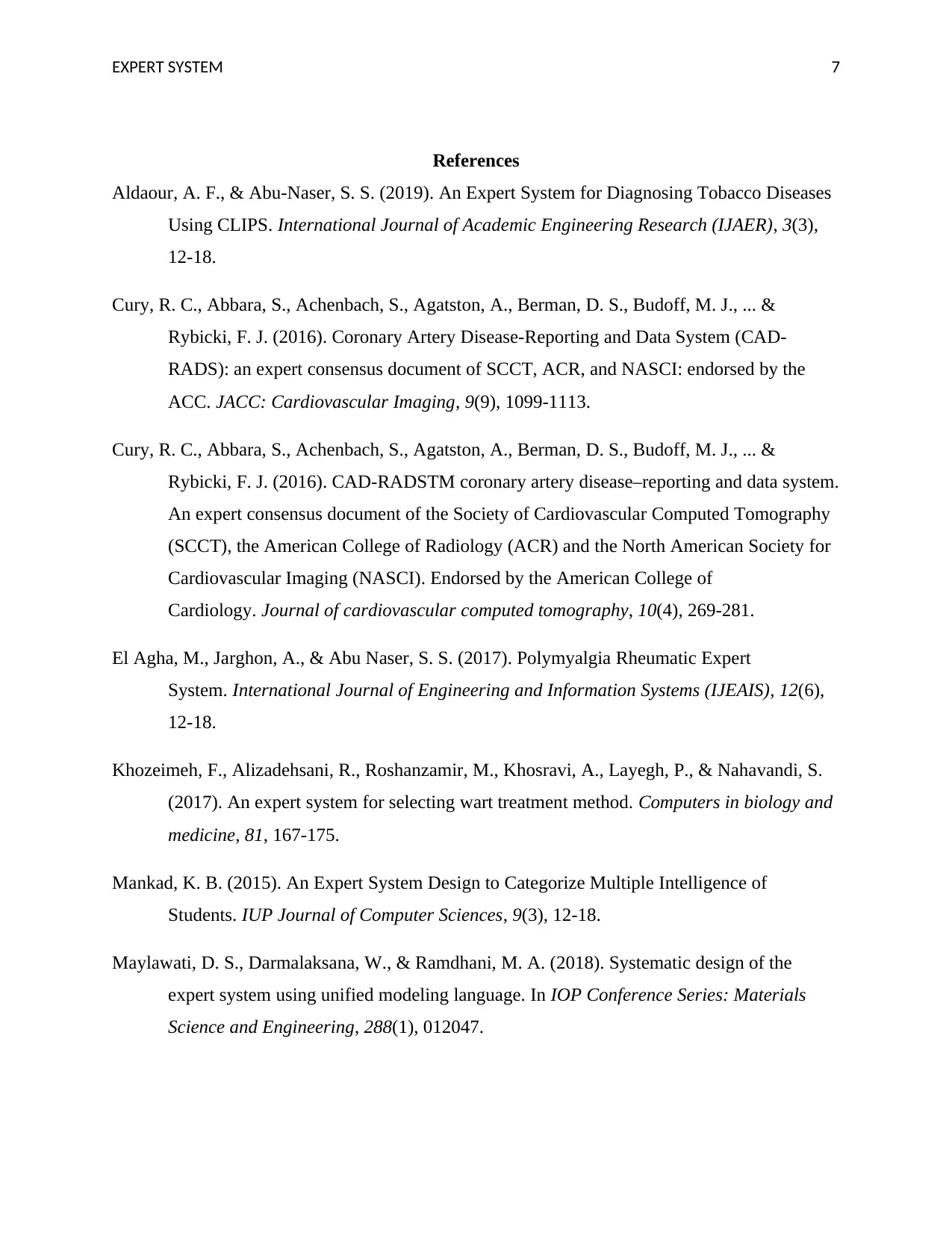
EXPERT SYSTEM 7
References
Aldaour, A. F., & Abu-Naser, S. S. (2019). An Expert System for Diagnosing Tobacco Diseases
Using CLIPS. International Journal of Academic Engineering Research (IJAER), 3(3),
12-18.
Cury, R. C., Abbara, S., Achenbach, S., Agatston, A., Berman, D. S., Budoff, M. J., ... &
Rybicki, F. J. (2016). Coronary Artery Disease-Reporting and Data System (CAD-
RADS): an expert consensus document of SCCT, ACR, and NASCI: endorsed by the
ACC. JACC: Cardiovascular Imaging, 9(9), 1099-1113.
Cury, R. C., Abbara, S., Achenbach, S., Agatston, A., Berman, D. S., Budoff, M. J., ... &
Rybicki, F. J. (2016). CAD-RADSTM coronary artery disease–reporting and data system.
An expert consensus document of the Society of Cardiovascular Computed Tomography
(SCCT), the American College of Radiology (ACR) and the North American Society for
Cardiovascular Imaging (NASCI). Endorsed by the American College of
Cardiology. Journal of cardiovascular computed tomography, 10(4), 269-281.
El Agha, M., Jarghon, A., & Abu Naser, S. S. (2017). Polymyalgia Rheumatic Expert
System. International Journal of Engineering and Information Systems (IJEAIS), 12(6),
12-18.
Khozeimeh, F., Alizadehsani, R., Roshanzamir, M., Khosravi, A., Layegh, P., & Nahavandi, S.
(2017). An expert system for selecting wart treatment method. Computers in biology and
medicine, 81, 167-175.
Mankad, K. B. (2015). An Expert System Design to Categorize Multiple Intelligence of
Students. IUP Journal of Computer Sciences, 9(3), 12-18.
Maylawati, D. S., Darmalaksana, W., & Ramdhani, M. A. (2018). Systematic design of the
expert system using unified modeling language. In IOP Conference Series: Materials
Science and Engineering, 288(1), 012047.
References
Aldaour, A. F., & Abu-Naser, S. S. (2019). An Expert System for Diagnosing Tobacco Diseases
Using CLIPS. International Journal of Academic Engineering Research (IJAER), 3(3),
12-18.
Cury, R. C., Abbara, S., Achenbach, S., Agatston, A., Berman, D. S., Budoff, M. J., ... &
Rybicki, F. J. (2016). Coronary Artery Disease-Reporting and Data System (CAD-
RADS): an expert consensus document of SCCT, ACR, and NASCI: endorsed by the
ACC. JACC: Cardiovascular Imaging, 9(9), 1099-1113.
Cury, R. C., Abbara, S., Achenbach, S., Agatston, A., Berman, D. S., Budoff, M. J., ... &
Rybicki, F. J. (2016). CAD-RADSTM coronary artery disease–reporting and data system.
An expert consensus document of the Society of Cardiovascular Computed Tomography
(SCCT), the American College of Radiology (ACR) and the North American Society for
Cardiovascular Imaging (NASCI). Endorsed by the American College of
Cardiology. Journal of cardiovascular computed tomography, 10(4), 269-281.
El Agha, M., Jarghon, A., & Abu Naser, S. S. (2017). Polymyalgia Rheumatic Expert
System. International Journal of Engineering and Information Systems (IJEAIS), 12(6),
12-18.
Khozeimeh, F., Alizadehsani, R., Roshanzamir, M., Khosravi, A., Layegh, P., & Nahavandi, S.
(2017). An expert system for selecting wart treatment method. Computers in biology and
medicine, 81, 167-175.
Mankad, K. B. (2015). An Expert System Design to Categorize Multiple Intelligence of
Students. IUP Journal of Computer Sciences, 9(3), 12-18.
Maylawati, D. S., Darmalaksana, W., & Ramdhani, M. A. (2018). Systematic design of the
expert system using unified modeling language. In IOP Conference Series: Materials
Science and Engineering, 288(1), 012047.
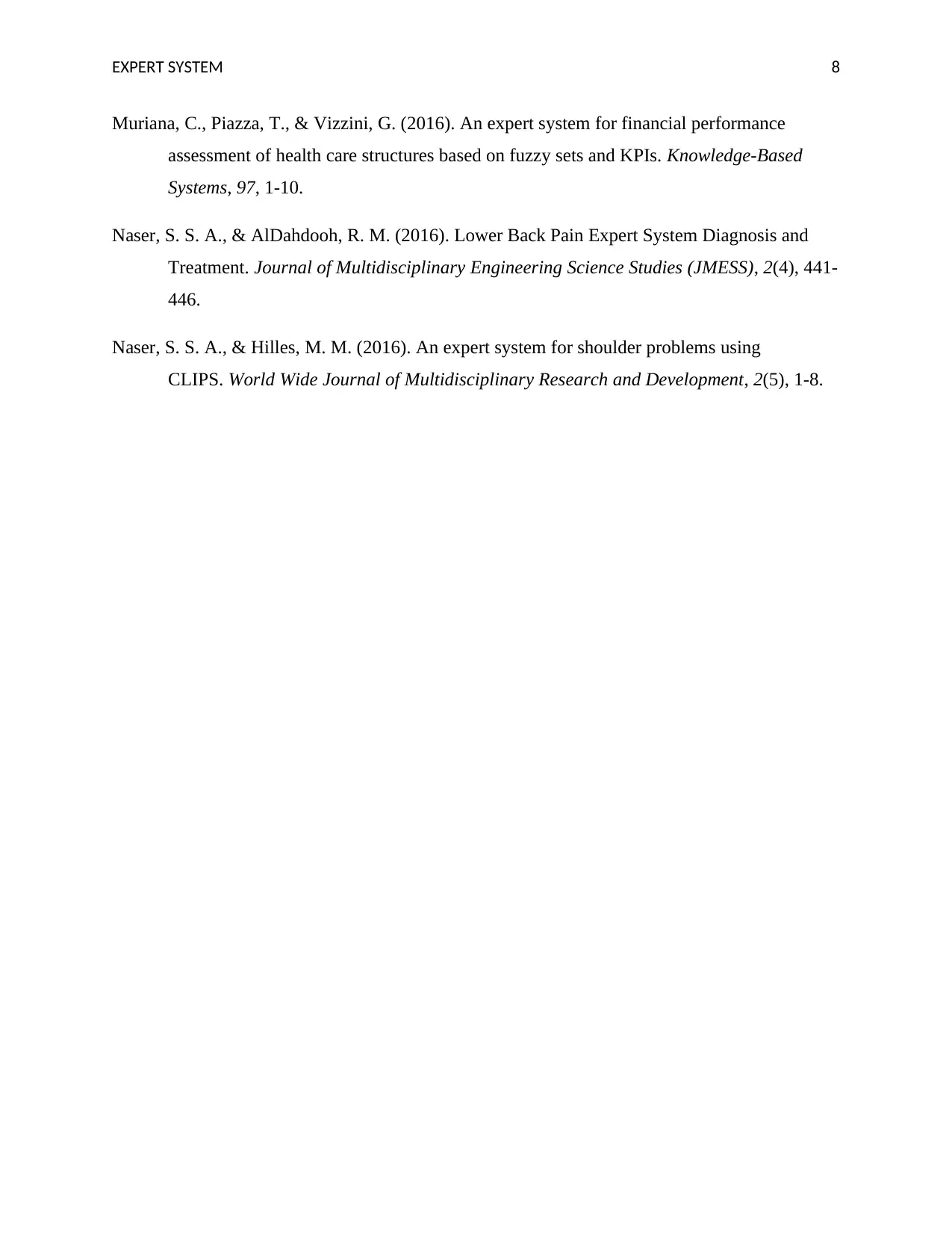
EXPERT SYSTEM 8
Muriana, C., Piazza, T., & Vizzini, G. (2016). An expert system for financial performance
assessment of health care structures based on fuzzy sets and KPIs. Knowledge-Based
Systems, 97, 1-10.
Naser, S. S. A., & AlDahdooh, R. M. (2016). Lower Back Pain Expert System Diagnosis and
Treatment. Journal of Multidisciplinary Engineering Science Studies (JMESS), 2(4), 441-
446.
Naser, S. S. A., & Hilles, M. M. (2016). An expert system for shoulder problems using
CLIPS. World Wide Journal of Multidisciplinary Research and Development, 2(5), 1-8.
Muriana, C., Piazza, T., & Vizzini, G. (2016). An expert system for financial performance
assessment of health care structures based on fuzzy sets and KPIs. Knowledge-Based
Systems, 97, 1-10.
Naser, S. S. A., & AlDahdooh, R. M. (2016). Lower Back Pain Expert System Diagnosis and
Treatment. Journal of Multidisciplinary Engineering Science Studies (JMESS), 2(4), 441-
446.
Naser, S. S. A., & Hilles, M. M. (2016). An expert system for shoulder problems using
CLIPS. World Wide Journal of Multidisciplinary Research and Development, 2(5), 1-8.
⊘ This is a preview!⊘
Do you want full access?
Subscribe today to unlock all pages.

Trusted by 1+ million students worldwide
1 out of 9
Related Documents
Your All-in-One AI-Powered Toolkit for Academic Success.
+13062052269
info@desklib.com
Available 24*7 on WhatsApp / Email
![[object Object]](/_next/static/media/star-bottom.7253800d.svg)
Unlock your academic potential
Copyright © 2020–2025 A2Z Services. All Rights Reserved. Developed and managed by ZUCOL.





